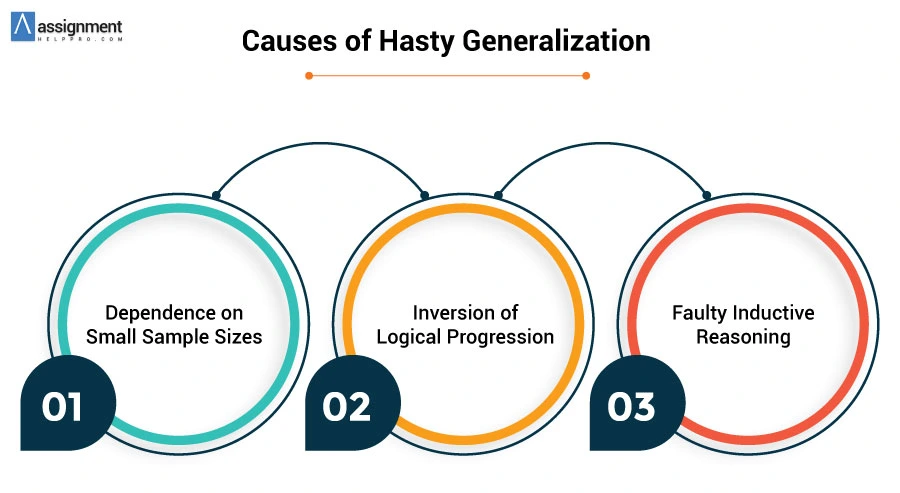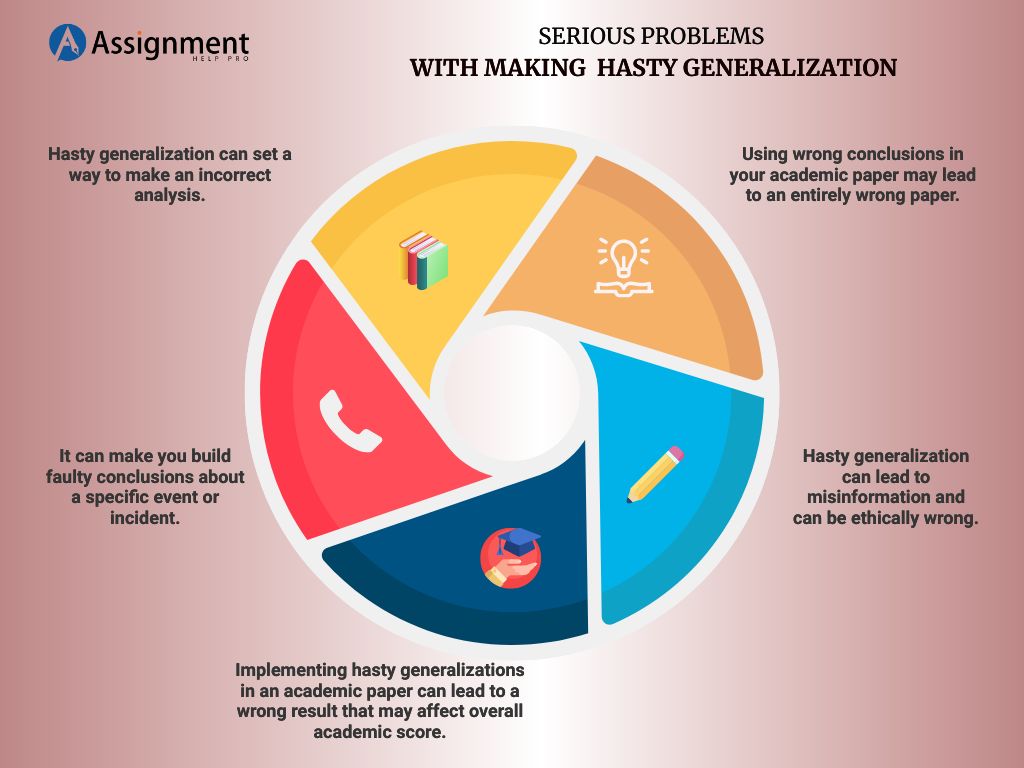When writing academic papers, it is common for us to make various kinds of fallacies. Basically, fallacy refers to reaching a conclusion with unjustified or incorrect reasoning or evidence. In literature, there are different types of logical fallacies. Out of them, hasty generalization is one of the most common errors that people tend to commit. Especially, while preparing academic papers a lot of students make this error and end up scoring low grades. Even at certain times, the hasty generalization fallacy can also pave the way to an entirely wrong paper. So, in order to help the students get a better understanding of hasty generalization, here, in this blog post we have given a detailed explanation about it with examples. Also, we have suggested how to avoid hasty generalizations in writing.

Continue reading this blog post to find out more about hasty generalization.
What is a Hasty Generalization?
Hasty Generalization is a type of logical fallacy that refers to reaching a particular conclusion based on a sample size rather than giving importance to statistics that are in line with a typical or average situation. In simple terms, a hasty generalization is a form of jumping to a conclusion with insufficient information or incorrect evidence.
Popularly, the hasty generalization is known by several other names as listed below.
- Secundum Quid
- Biased Generalization
- Converse Accident
- Faulty Generalization
- Insufficient Sample
- Jumping to a Conclusion
- Neglect of Qualifications
Till now, we have seen what a hasty generalization means. Next, let us see the major reasons for hasty generalization.
Major Causes of Hasty Generalization
In general, there might be a lot of reasons for a logical error to occur. Listed below are some common causes that lead to the hasty generalization fallacy.
- Dependence on small sample sizes
- Inversion of logical progression
- Faulty inductive reasoning

Dependence on Small Sample Sizes
One of the potential causes of hasty generalization is reaching a conclusion based on a sample size that is too small. Say, for example, your younger sister, who is studying in grade 3, loves watching wrestling. With this information, you could generalize that all younger girls will watch wrestling. However, it would be an example of a biased generalization. Here, you are reaching a conclusion purely based on your sister, without taking into account people of other ages and gender.
Inversion of Logical Progression
Another cause of hasty generalization is drawing a conclusion or explaining a point by inverting a logical progression. It is also known as the Secundum Quid Fallacy. Say, for example, your younger sister who loves watching wrestling also watches Animation Movies. With this detail, you could arrive at the conclusion that people who watch wrestling also love watching animated movies. However, if you invert a statement to explain a point, then your entire statement will become incorrect.
Faulty Inductive Reasoning
Yet another cause of faulty generalization is jumping to a conclusion based on wrong evidence. Say, for instance, you arrive at your home and find the papers in your medical file spread all over your room and your dog looking guilty. On seeing this scene, you would conclude that your dog is the culprit. However, it is a kind of inductive generalization where you reach conclusions without analyzing what would have happened.
Different Examples of Hasty Generalization
Here we have shared some interesting hasty generalization examples. Go through them all to understand the concept better.
Example 1
When I was young, my brother never helped my mom with household chores. All men are useless.
Explanation: It is extremely wrong to derive a conclusion that all men are useless by just considering the case study of one person.
Example 2
I ate in four restaurants in Hanoi and didn’t love the experience. There are no good restaurants in Hanoi.
Explanation: It is not correct to come to the conclusion that all the restaurants in Hanoi are not good by visiting only four restaurants.
Example 3
My friend who smoked five packs of cigarettes a day since age sixteen lived until age seventy. Therefore, smoking can’t really be that bad.
Explanation: It is purely wrong and dangerous to jump to a universal conclusion about the health risks of smoking from the experience of one man.

Critical Problems of Hasty Generalization in Writing
One of the most serious mistakes that writers should avoid is a hasty generalization. If you use a hasty generalization fallacy in your writing, you run the risk of running into multiple issues. When you make hasty generalizations in your academic paper, you may run into the following serious issues:
- If you use the wrong conclusions in your academic paper, it could end up being completely wrong.
- It can lead you to draw incorrect conclusions about a particular incident or event.
- An incorrect analysis can be set in motion by making hasty generalizations.
- It can be unethical to make hasty generalizations because it can spread false information.
- In an academic paper, using hasty generalizations can result in a wrong result that can have a significant impact on your overall academic grade or score.
Know How to Find Hasty Generalization in a Paper
In order to find out hasty generalizations, you must have some excellent critical thinking skills. But sometimes, it would become too hard to detect faulty generalizations in a piece of writing. If you wish to spot hasty generalizations in writing, then make sure to execute the following steps.
- Firstly, analyze the person who gives the opinion. Check whether that person is very subjective or normally objective. The answer will give a clue to the validity of that person’s claim.
- Next, check and find out the sample size the person has used to reach the conclusion. If the sample size is small, then high chances are there for assumptions with insufficient data. In case, the sample size is large, the conclusion might be reasonable.
- Finally, see the sources or evidence used by the person. If the conclusion is derived from a trusted source or proper evidence, then the statement might be valid.
Guidelines to Avoid Hasty Generalization in Writing
As previously stated, making hasty generalizations in your writing can sometimes sabotage all of your preparation efforts for an academic paper. Therefore, avoid making hasty generalizations when writing an academic paper. Follow the guidelines below if you are unsure of how to avoid making hasty generalizations in your writing.
- Consider a large sample size. Remember to draw conclusions from a sample of data that is too large if you want to generalize.
- Write about the fact that your sample size is too small.
- Try to provide counterexamples because focusing on multiple arguments will make your writing more thorough.
- Be mindful so as not to sum up. However, if you want to make generalizations, you must have sufficient evidence from reliable sources to support your claims.
- Conduct in-depth research and gather sufficient valid evidence for a single claim in order to prepare an informative academic paper.
- To the best of your knowledge, write accurately. Try to use precise language, especially when dealing with statements based on inductive reasoning. Also, don’t dilute your statement to the point where it’s unclear.
Get Professional Academic Writing Help
It’s time to wrap up! We hope you have gained a better comprehension of hasty generalization. In case, you have any queries regarding this fallacy or if you need academic writing help from an expert, call us immediately.



